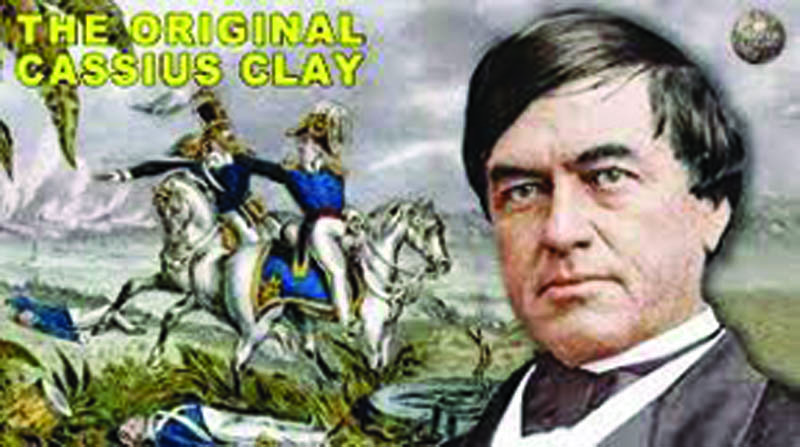The Lion of White Hall, Part 3 of 4
From the Mountains

Tom Marshall headed the mob that nearly killed Clay and destroyed his newspaper office.
Although they were both captains in the Mexican War not long thereafter their interests went in different directions, their relationship became intense and it wasn’t long before Clay challenged Marshall to a duel.
“Marshall rode over to his tent and soon he came back with his pistol,” Clay related. “I went in my tent and came back out with a pistol in each hand. Both were cocked. Evidently Marshall was somewhat a coward because he turned his horse and rode back to his tent.
“Later that evening he tried to drown himself in the Rio Grande River but some of the men saw him and stopped it. As I said before some are afraid to fight but not afraid to commit suicide.”
Clay was asked about his encounters with Sam Brown.
“I was in a political race against a man named Wickliffe and he chose to say some disparaging things about my wife in one of his speeches,” Clay recalled.
“I challenged him to a duel in which we would fire at ten paces. Both of us missed but I believe there was collusion between our seconds and they hadn’t loaded our pistols with balls. The guns fired but there were no balls in them to be fired.
“I demanded a second firing but the seconds would not permit it and we all left the grounds. Again I’ll say I wouldn’t miss him at ten paces. I can shoot the heads off eleven out of twelve squirrels at a much greater distance.”
Wickliffe’s campaign for Congress wasn’t going well and the pro-slavery party was concerned.
On one occasion Wickliffe and Clay were scheduled to give speeches on the same platform.
“During his speech I rose and asked if I could interrupt him as what he was saying was untrue.,” Clay explained. “The pro-slavery men were upset with me and called for Sam Brown to confront me.
“Brown was one of the biggest bullies in Kentucky. It was said he had forty fights and never lost a one. I learned the next day that Brown was armed at my speech and I didn’t have my dueling pistols. While Wickliffe was giving his speech I interrupted him again and when I did Sam Brown called me a liar and hit me with his umbrella. When I saw it was Sam Brown, I knew there would be a fight and it would be serious. I had a long bowie knife in my breast pocket and jerked it out but Brown’s friends grabbed my arms and hauled me back about fifteen feet. Then I saw that Brown had drawn his revolver, telling his cronies to move away from me. They withdrew and I stood alone and he had his pistol pointed at me.”
Clay started toward him but a loud blast was followed by a sharp stinging in my breast.
“I thought it had gone clear through me and I decided to kill him if I could before I died. I came down on his head with a tremendous blow with my knife, splitting his scalp open but not his skull. I struck him again and again, keeping him off-guard so he was not able to fire. With one cut of my knife, I sliced his nose right in two, leaving it looking like a pancake. Another cut left his ear hanging by a shred and with another I put out his eye.
“Brown’s conspirators grabbed me and struck me with hickory sticks and chairs but I broke away and again went after him. They picked him up and threw him over a seven-foot fence to keep me away from him. It ended the fight and although I was the assaulted party, they tried me in court for mayhem.”
Henry Clay, the famous statesman and presidential candidate defended his cousin in court and surprisingly he had Sam Brown confess to the conspiracy that resulted in an acquittal for his cousin.
“I wrote a note of thanks to Sam Brown for his evidence. I told him I was willing to be friends and bury the hatchet without any further problem. He wasn’t agreeable with that and I understand why. The doctors patched him up as best they could but he was still a horrible looking object. I fully expected he would insist on a duel or even worse attack me unexpectedly to get his revenge. I met him several times after that however and he never touched me. I have no doubt that he stayed in Lexington with the intent to kill me but probably didn’t have the courage to do so after considering our previous melee.”
Frank Carpenter, the reporter interviewing Clay in 1891, was curious and asked where Brown’s pistol ball had struck him. “Just over my heart,” Clay replied.
“It would have killed me but when I jerked my knife out of the scabbard, which was tipped with silver, it was pulled up just over my heart. The ball struck and became embedded in the silver. There was a red spot and then a bruise over my heart. The whole matter seemed providential… like it was an act of God that I was still alive.
Copyright 2023 Jadon Gibson. Code duello appears to be the remedy of action in the next issue. Jadon Gibson is an Appalachian writer from Harrogate. His stories are both historic and nostalgic in nature. Thanks to Lincoln Memorial University, Alice Lloyd College and the Museum of Appalachia for their assistance.


